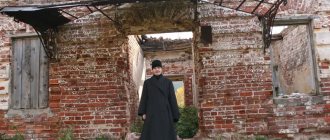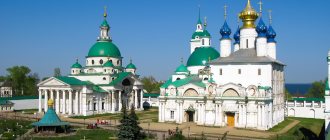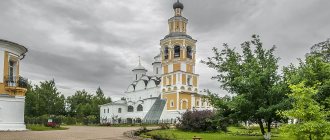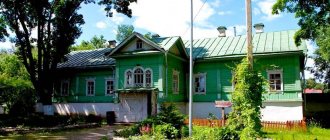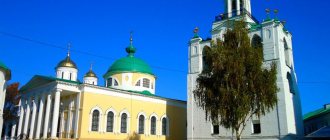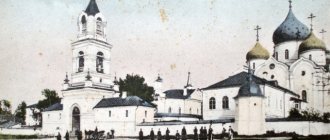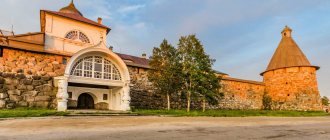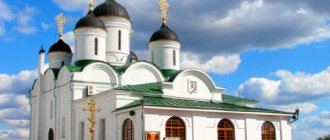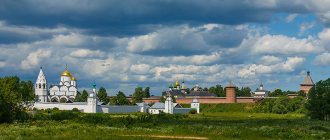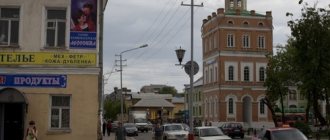| Spaso-Eleazarovsky Monastery. Photo from the 2000s. |
Spaso-Eleazarovsky Great Desert Convent in the name of the Three Ecumenical Saints in the village.
Elizarovo, Pskov diocese
- Address: Russia, 180523, Pskov region, Pskov district, village. Elizarovo
- Tel.
- Official site:
- Travel: by suburban bus to Elizarovo, or by bus route Pskov - Seredka and Pskov - Gdov
- On the map: Yandex.Map, Google map
In the 12th century, nuns of the Pskov St. John the Baptist Monastery appeared on the site of the future monastery, but they could not bear the difficulties of desert living and soon left.
The monastery was founded by the monk Euphrosynus, a monk of the Snetogorsk monastery, who settled on the Tolva River, not far from Pskov, around 1425. Over time, he began to accept followers and students. The original name of the monastery was Sretensky
- in memory of the meeting of the Constantinople Icon of the Mother of God, brought here by Saint Euphrosynus from the Eastern Roman Empire.
At the meeting place of the icon, there was a holy spring, in which you can plunge now. However, the founding date of the monastery is usually considered to be 1447, when the first monastery church was erected in the name of the Three Ecumenical Hierarchs and St. Onuphrius the Great. This dedication was chosen after Saint Euphrosim began to pray for the name of the monastery’s temple and on the spot where the cathedral now stands, he had a vision of the Three Hierarchs, which is why from then on the monastery began to be called Three Hierarchs
.
The Monk Euphrosynus, the leader of the Pskov desert dwellers, raised many glorious disciples, who also created monasteries and carried the blessed seeds of asceticism throughout the Pskov land. Among the disciples of the Venerable Euphrosynus, the monastery elders, the Venerable Savva of Krypetsky, Dositheus of Verkhneostrovsky, Onufriy Malsky, Joachim of Opochsky, Hilarion of Gdovsky, Chariton of Kudinsky, locally revered brothers from Pskov, the holy abbots of the Spaso-Eleazarovsky monastery Ignatius, Charalampius and Pamphilus, buried in Spaso-Eleazar ovsky monastery The Monk Serapion of Pskov was also a disciple of the Monk Euphrosynus. Soon after his death, the Monk Euphrosynus, who probably took the name Eleazar in the schema, began to be revered as a saint, and the monastery became known as Eleazarovskaya
in his honor.
The monastery was for men and was distinguished in ancient times by the strictest regulations; the monks of the monastery were called “iron”. Soon the monastery became the center of Pskov chronicles and icon painting. It is assumed that in the 16th century the Tale of Igor’s Campaign was rewritten here, and this list survived until the 19th century, when it received the name “Musin-Pushkin List”. In the 16th century, Elder Philotheus of Pskov was abbot here and expressed the formula of Russian Orthodox statehood: Moscow is the Third Rome; “ Two Romes have fallen, the third stands, the fourth will not exist.”
».
When the ecclesiastical states were published in 1764, it was left to its contents. In 1766, the brethren of the abolished Velikopustinsky Transfiguration Monastery were transferred to it, which is why the monastery was also given the name Velikopustinskaya
and
Spasskaya
. In the monastery church, a throne was consecrated in honor of the Transfiguration of the Lord, and the shrines of the Great Desert monastery, including the ancient miraculous image of the Savior, were transferred here.
In 1813, the monastery was elevated to the 2nd class, which it remained until the end of the Synodal period.
Since 1884, an almshouse operated at the monastery.
Before the First World War, the elder and confessor of Grand Duchess Elizabeth Feodorovna, Schema-Archimandrite Gabriel (Zyryanov), labored in the monastery. With the beginning of the war, the monastery was evacuated to the Kazan diocese.
During the years of Soviet power, the monastery was ravaged and destroyed. In the 1990s, the dome and drum of the monastery Cathedral of the Three Saints collapsed.
On May 28, 2000, in the Spaso-Eleazarovsky Monastery, for the first time in eighty years, the Divine Liturgy was celebrated by the bishop's service. With the blessing of the Pskov Bishop Eusebius, as well as through the efforts and labors of the monastery sisters and donors, the monastery is being revived. Within four years after the restoration of monastic life in 2000, already as a convent, the Spaso-Eleazarovskaya monastery was raised from the ruins.
As of 2007, the basis of the life of the monastery is the fulfillment of the full circle of statutory Divine services, caring for the spiritual care of sisters, monastery workers and local residents. At the monastery's courtyard in the city of Pskov, the restoration of the building of the monastery cells continued, and the Church of Mid-Pentecost is in operation. The monastery provided spiritual and material support to the needy population, charitable assistance to residents from socially disadvantaged families, and students of schools in the surrounding villages. Every day the monastery received pilgrims and guests, and provided spiritual and moral support to drug addicts undergoing rehabilitation in the monastery.
Statistics
- OK. beginning 2005 - 8 nuns were tonsured; 4 nuns, 6 novices live, the rest are candidates [1].
- con. 2007 – 20 nuns [2]
How the monastery was founded
The first to settle in the place where the monastery now stands were the sisters of the Pskov Convent of St. John, which was located in Pskov. However, it was difficult for women to develop the forest wasteland located near Lake Peipus, and soon the community left it.
Time passed, and in 1425 the 29-year-old monk of the Snetogorsk monastery Efrosin ended up here. He was born in the village of Videlibye in the Pskov region and before becoming a monk bore the name Eleazar. It is known that the monk was well educated and was considered a great book lover and a theologian. As a monk, Euphrosynus made a pilgrimage to Constantinople and met the patriarch there.
At first the monk lived alone in the forest, but gradually other hermits gathered around him. The place where they settled was remote from people. Makeshift wooden cells stood under a hill, between two branches of the Tolba River. And although everyone wanted to build a monastery here, there was not much room for the construction of temples and other buildings in the river floodplain.
View of the monastery from road 58K-96
According to the surviving legend, Efrosin saw a dream in which three saints appeared before him. They gave the elder advice - to tear down the hill and cover one of the Tolba branches with earth.
Euphrosynus told the monks about the miraculous vision, and they acted on the advice of the saints. On the resulting site, thanks to the monks and peasants, a cathedral and new monastic cells appeared.
In the history of the church, Euphrosyne is revered as an ascetic and mentor. He became a teacher for many monks who, leaving the walls of their native monastery, founded 10 other monasteries in the Pskov lands. It is curious that many of his students were later canonized by the church.
Efrosin himself was distinguished by great modesty and preferred to lead a solitary life. Therefore, even when the monastery was founded, he did not take on the duties of its abbot and did not accept the priesthood. The first to lead the brethren was Abbot Ignatius.
View of the monastery from the pond
Shortly before his death, Efrosin took the schema under his worldly name Eleazar. The elder died in 1491 at the age of 95, and was buried in the Cathedral of the Three Hierarchs. According to Efrosin's will, all property belonging to him was divided among the brethren, and in memory of the founder the monastery began to be called Eleazarovsky.
History of the monastery from the 16th century to the present day
The Pskov-Pechersk monastery advocated maintaining the independence of Pskov from the Moscow princes. The Eleazarovsky Monastery, on the contrary, called for the unification of scattered lands under the leadership of Moscow. At the beginning of the 16th century, Elder Philotheus lived in the monastery. Almost no information about this monk has survived, with the exception of his messages addressed to the Grand Duke of Moscow Vasily III. The monk wrote several letters, and in one of which he said that two Roman empires were destroyed, Moscow is the third Rome, and “there will never be a fourth.”
In his letters, Philotheus called Basil III “the Orthodox Tsar” and called not to break the commandments laid down by his great predecessors - Emperor Constantine, Saint Vladimir and Yaroslav the Wise. This concept was taken up by the Grand Duke and formed the basis of Russian statehood. The interpretation “Moscow is the third Rome” became widespread, and starting from John III, all Moscow sovereigns were considered the successors of the emperors of Rome and Byzantium.
Cathedral of the Three Saints. View of the southern façade of the cathedral
The monks of the Eleazarovsky Monastery were engaged in the creation of handwritten books. The monks who lived here compiled the life of the founder of the monastery, Elder Euphrosynus, edited the second Pskov Chronicle, and also rewrote the old copy of “The Tale of Igor’s Campaign.” It was this manuscript that was discovered at the end of the 18th century by the famous collector of antiquities, Count Alexei Musin-Pushkin.
The border position had a negative impact on the monastery. It was repeatedly robbed by Lithuanians, Poles and Livonian knights who attacked Russian lands. By the middle of the 18th century, the role of the Eleazar monastery decreased. Monks were transferred to it from several monasteries abolished by decree of Catherine II, and the monastery received the status of a second-class monastery.
At the beginning of the 20th century, daily services were held here, and there was an almshouse supporting the elderly and disabled. The monastery lived according to the communal rules. The monks tried to adhere to an ascetic lifestyle following the example of the founder of the monastery, Elder Euphrosynus. The inhabitants carried out all the household work, and also worked in carpentry, tailoring and shoemaking workshops.
First nursing corps
In 1918, the new authorities closed the monastery, and the monks were sent on carts towards Petrograd. According to surviving documents, all the monks were shot.
Until 1920, the life of the monastery church was maintained by the efforts of several believers, and several times visiting commissions removed church valuables from it.
Then an institute was organized on the monastery territory, however, professors and students soon moved to St. Petersburg. For a long time, the former monastery alternately housed experimental agricultural production, the People's House, an educational institution for mentally retarded children, a sanatorium for those suffering from tuberculosis, and a recreation center. Then there was a children's camp and living quarters here.
By 1999, only the ancient Trinity Cathedral with a destroyed bell tower and the building for the brethren, built at the beginning of the last century, had survived from the old monastery buildings.
A year after the transfer of the territory of the convent, the first church service was held here. And then, for several years, Pskov restorers restored churches and buildings.
Chapel of the Savior of the Image Not Made by Hands
Attempts to rebuild the monastery in a secular way
The authorities repeatedly tried to find a use for the monastery buildings, but each time it ended in failure. At the end of the twenties, the ruined monastery was transferred to one of the Pskov institutes, but, unable to adapt to classes in dilapidated premises, students and teachers soon left it.
The organization of exemplary agricultural production in the monastery also ended ingloriously - nothing that was planted stubbornly wanted to grow. After this, the former monastery changed owners several more times, each time becoming more and more destroyed. In a short time, the new authorities destroyed what had been created by the labors of the monks over many centuries.
What can you see in the monastery these days?
Today the monastery has been beautifully restored. The main thing in it is the majestic Trinity Cathedral.
The first stone temple appeared on this site in 1447, and then was rebuilt many times. Today it is a three-apse, single-domed church with a small bell tower above the stairs. It has 7 bells cast by Voronezh craftsmen.
In the snow-white abbot's house there is a small temple of the Archangel Gabriel. Near the road there is a recently built beautiful chapel of the Savior of the Image Not Made by Hands. And in the building occupied by the pilgrimage center, its own house temple was created. In addition, on the monastery territory surrounded by a fence, there are two sister buildings and outbuildings.
Shrines of the Spaso-Eleazarovsky Monastery
Like many monasteries in Russia, the monastery near Pskov houses ancient icons revered by believers. One of them, the Constantinople Icon of the Mother of God, appeared in Constantinople in the middle of the 11th century, and later ended up in the Spaso-Eleazarovsky Monastery.
Tomb of Mother Superior Elisaveta
The Livonian knights who plundered the monastery took the shrine with them. It is believed that the icon drowned in Lake Peipsi. Soon after this, a copy of this icon appeared in the monastery, which has survived to this day. The icon is written on a cedar board in ancient Greek script. It depicts the Mother of God with her son, and a dove can be seen in the hands of Jesus.
Another shrine of the Orthodox monastery is the icon of the Savior of Eleazar, which is considered a masterpiece of ancient Russian art.
She appeared in 1352 and was revered as miraculous. In the 14th century, they walked around Pskov with this icon, and according to legend, a crowded religious procession stopped a pestilence epidemic.
The iconographic image arrived at the monastery in 1766. In the 20th century, it ended up in Moscow for restoration and was returned to the Pskov region only in 2010. Nowadays, the icon is dressed in a special icon case, equipped with an alarm system and stored at constant temperature and humidity.
beat
Elder Philofios
Having gone through a long and arduous path, Euphrosynus departed to the Lord at the age of ninety-five years, accepting the schema with the name Eleazar before his death. In honor of this, the Pskov Spaso-Eleazarovsky Monastery, founded by him and existing to this day, is named. The life and service of the ascetic became a good grain that fell on fertile soil and grew in future generations of holy fathers who labored within the walls of the monastery.
The most famous of them is Elder Philofius - the first to point out the great mission of the Russian people and its role in the fate of Orthodoxy. It was he who, after the capture of Constantinople by the Turks, said that for apostasy from the true faith the Lord allowed the fall of the First Rome - an empire that fell into the Latin heresy, and after it the Second - Byzantium, which concluded an unholy union (alliance) with the Latins. From now on, all responsibility for the purity of Orthodoxy falls on Rus'. The Lord promised her to become the Third Rome, and the Fourth would no longer exist.
The Spaso-Eleazarovsky Monastery greatly served the cause of unifying the Russian lands around Moscow, becoming their spiritual center and gathering many learned men within its walls. And again, the voice of Elder Philofius was heard throughout the whole country, supporting the Grand Duke of Moscow with his authority and thereby placing the reins of government of a huge state into his hands.
How to get there
The monastery is located in the village of Elizarovo, 29 km north of Pskov.
By car you can approach it along highway 58K-96, leading to Gdov. Within the city blocks of Pskov, this is Leon Pozemsky Street. The monastery territory is located to the west of the road, on the left bank of the Tolba River.
Church shop
Elizarovo is reached in 30-40 minutes by buses going from Pskov to Gdov, Verkholino, Samolva, Seredka and Znamenka. They depart from the city bus station, which is located next to the Pskov-1 (Pskov-Passenger) railway station. In addition, you can get to the monastery from Pskov by taxi.
Attraction rating
Rating 4.67 [3 vote(s)]
| ← Russia | Pskov region | Europe → |
Abbots, abbess
- St. Ignatius (second half of the 15th century)
- St. Varlaam (Petrov) (1764 - no later than 1768)
- Afanasy (Telyatev) (January 26, 1810 - October 30, 1819)
- Melchizedek (Zolotinsky) (January 30, 1829 - 1841)
- Anthony (Shokotov) (June 23, 1841 - January 24, 1845)
- Sschmch. Juvenaly (Maslovsky) (ca. 1905 - October 16, 1906)
- Anatoly (Junger) (October 23, 1910 - December 21, 1910)
- the monastery was abolished
- Rafaila (Skorodumova) (2010 - 2012) acting
- Euphrosyne (Golovneva) (August 19, 2012 - April 16, 2016) acting
